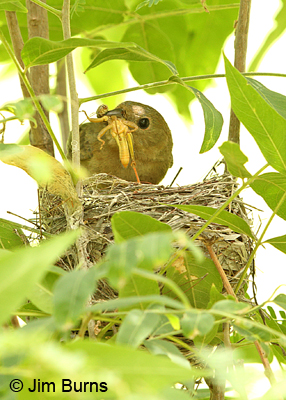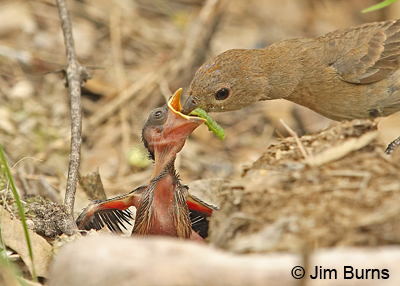
Somewhere on the hillside behind me a Greater Roadrunner is cooing softly, the plaintive, dove-like call that the uninitiated never attribute to the wily, irascible, bloodthirsty state bird of New Mexico. A friend once recounted how “her” roadrunner sidled up next to a flock of House Finches drinking at her water feature, calmly took a long sip, then grabbed the closest finch by the neck and proceeded to bash it against the concrete basin before swallowing it whole. Roadrunners are not for the faint of heart.
I notice a small dark bird in a low bush out along the edge of the wash, dismiss it as one of the several Bell’s Vireos singing all around me, and don’t even touch the binoculars as I reach to peel my last banana. The rain lets up, then starts anew, anything but a downpour, just a gentle, desultory infusion of moisture into the already stifling afternoon monsoon humidity. Strongly considering a nap, I see a small dark bird, perhaps the same one, in the same bush.
Curious now, banana in one hand, binoculars in the other, I focus on the bush and, sure enough, see the oval blob that can only be a nest. Making quick work of the banana, I brace both elbows on the table, both hands now around the glasses. The bird emerges from the twiggy blob and disappears down the wash. I wait patiently. When I see her again, she has approached stealthily and landed on a low, small branch in a tree next to the nest bush. Sure of what I’m witnessing now, nap entirely forgotten, I go to the van and get the tripod and telephoto lens.
It is a female Varied Bunting, perhaps the drabbest of all Arizona breeding birds, and she should have two babies in the cup nest which is too far away and just high enough that I cannot see into it. Her next delivery is a large yellow grasshopper, one of countless underfoot everywhere this time of year in the desert foothills. The baby buntings must be very young because, as I watch through the lens, I can neither hear them peeping nor see them thrusting upwards for her attention when she comes in.
This time the female departs with a fecal sack and, as she hurries down the wash, movement on the ground arrests my vision. There, halfway between the nest and me, a baby bird so small it sports only a few pinfeathers, is doing its begging thing. Too young to even walk, let alone fly, I can’t believe it has escaped the nest and covered ten yards out along the rough ground through stones, leaves, and cow pies. How . . . and why? And does the mother realize? I watch, enthralled.
Yes, she comes in low again, to a branch directly over the prodigal, obviously aware of the situation and also of my close presence. I hear it peeping now, and freeze as she assesses what to do. She has another grasshopper. The instinct of motherhood trumps the proximity of the looming, five-legged predator. She drops to the ground and transfers the insect. She reaches down and plucks ants from the helpless baby’s nearly naked body, then returns to the nest.
Varied Buntings are frequent hosts to parasitizing cowbirds, but this bird on the ground is much too small to be a cowbird. Perhaps the baby in the nest is a cowbird chick which has crowded its adoptive “sibling” out. It is raining harder now. I think about the ants. I remember the roadrunner.
Reflexively, without a thought to the long and winding debate over interference with nature, I walk to the baby. Smiling inwardly remembering what the tennis pros will tell you about holding your racquet like a baby bird—not too loose (or it will wriggle out), and not too tight (or you will crush it), I pick the baby up and carry it to the nest. The mother flies out as I approach. There is one young in the nest, a twin the same size as the one I have. I open my hand and it slides down to join its sibling. I hurry to the van through a now driving rainstorm and fall asleep wondering if mother buntings can count and whether they can feel relief or gratitude.